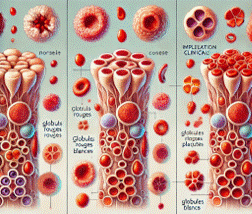Definition
Blood is composed of various types of cells: red blood cells (erythrocytes), white blood cells (leukocytes), and platelets (thrombocytes). When there is a quantitative deficiency in one of these cell types, the term “cytopenia” is used—the most well-known being anemia, or a lack of red blood cells. These cells are produced in the bone marrow, the soft tissue inside bones. All normal blood cells originate from a stem cell, a kind of “mother” cell of the blood system. Fortunately, our bone marrow contains a large number of stem cells that initially share the same characteristics.
As with all dividing cells, genetic mutations can occasionally occur. In the case of clonal hematopoiesis, a genetic mutation arises in one of the bone marrow stem cells, which over time may lead to abnormal proliferation of that cell, forming a group of identical cells known as a clone. These clones, which generally coexist with normal cells, can trigger inflammation in the bone marrow and surrounding tissues by releasing small molecules or through altered interactions with immune cells.
Which Diseases Are Linked to Inflammation Caused by Clonal Hematopoiesis?
The presence of one or more clonal populations is now recognized as being associated with several diseases familiar to hematologists and internists, including:
-
Myelodysplastic Syndromes (MDS): Age-related diseases characterized by abnormal and/or insufficient blood cell production in the bone marrow.
-
Myeloproliferative Neoplasms (MPN): Conditions involving excessive production of mature blood cells.
-
Clonal Hematopoiesis of Indeterminate Potential (CHIP): An earlier stage that may progress to MDS or MPN. In these patients, a clonal mutation is present without causing cytopenia, but it may increase the risk of cardiovascular disease or progression to MDS or MPN.
All three categories may be accompanied by clinical and/or biological signs of inflammation.
This has led to the proposed term CHIS (Clonal Hematopoiesis of Inflammatory Significance) as a common starting point for these entities
Etiology
According to current knowledge, these conditions are not hereditary in most cases. They often appear with age, as our cells accumulate mutations over time. Certain factors—such as exposure to toxic substances (chemicals, radiation) or cancer treatments—can also increase the risk of developing clonal populations.
Clinical
Symptoms vary depending on the degree of inflammation and may include:
-
Fatigue: due to anemia
-
Recurrent infections: due to a decrease in functional white blood cells
-
Bleeding or bruising: due to a lack of platelets
-
Fever, joint pain, digestive issues, skin or mucosal rashes: depending on the affected organ
Diagnostic
Diagnosis is based on blood tests, including molecular analysis of blood cells and measurement of various inflammatory markers. In some cases, a bone marrow aspiration (myelogram) may be necessary.
Treatment
Treatment depends on the type and severity of the clonal hematologic disorder:
-
Active surveillance for less aggressive forms
-
Medications, including biotherapies, to control symptoms or regulate blood cell production
-
Chemotherapy or bone marrow transplant for more severe cases
Conclusion
Clonal hematopoiesis is a recognized entity by the WHO, with inflammation as a key feature. It may or may not lead to a specialist consultation. Ongoing research, with patient involvement, will help improve our understanding of the underlying mechanisms and lead to increasingly targeted treatments that reduce the risk of progression to more aggressive diseases.


